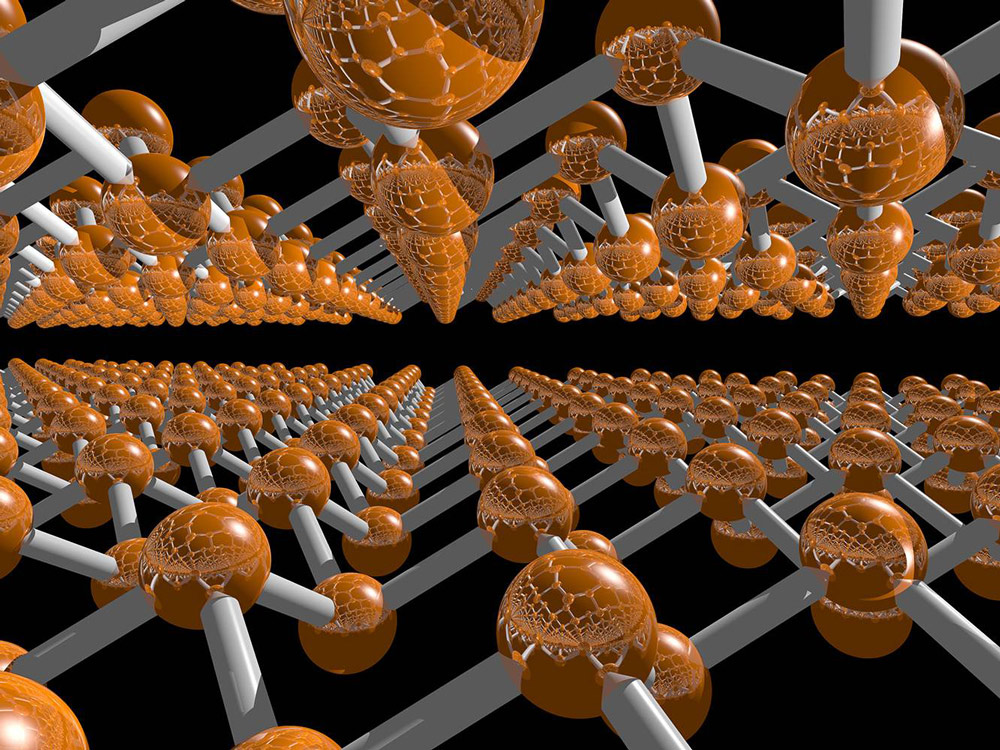News: Microelectronics
23 November 2020
Blue phosphorus 2D semiconductor monolayer becomes metallic as a bilayer
An interdisciplinary team led by professor Thomas Heine at Germany’s Technische Universität Dresden and professor Gabriel Merino at the Mexican research institute Cinvestav Merida has discovered that blue phosphorus, an atomically thin synthetic semiconductor, becomes metallic as soon as it is converted into a double layer (Jessica Arcudia, et al, Phys. Rev. Lett. (2020) 125, 196401). The researchers are said to be first to describe the possibility of constructing nanoscale, highly efficient transistors consisting of only one element.
The chemical element phosphorus is considered to be one of the most essential elements for life. Phosphorus compounds are deeply involved in the structure and function of organisms. Every human carries about 1kg of it in the body. But even outside our bodies we are surrounded by phosphates and phosphonates every day: in our food, in detergents, fertilizers or in medicines.
Phosphorus occurs in several modifications that have extremely different properties. Under normal conditions, a distinction is made between white, purple, red and black phosphorus. In 2014, a team from the Michigan State University in the USA computationally predicted blue phosphorus, which could be produced experimentally two years later.
Due to its single-layer honeycomb-like structure, blue phosphorus is reminiscent of what is probably the best known two-dimensional (2D) material: graphene. Analogous to graphene, it was then also called blue phosphorene. This novel semiconductor material has since been investigated as an extremely promising candidate for optoelectronic devices.
In cooperation with Mexican scientists, TU Dresden chemist professor Thomas Heine has now made a unique discovery: by applying a topological concept they identified computationally a remarkably stable two-layer buckled honeycomb structure of blue phosphorene by means of highly precise calculations on high-performance computers. This two-layered compound is extremely stable. As the researchers surprisingly discovered, it has metallic properties due to the very small distance between the two layers.

Picture: Computer model of a two-layer buckled honeycomb structure of blue phosphorus. The compound is very stable and (due to the very small distance between the layers) has metallic properties. Copyright: Jessica Arcudia.
Like all components, these devices must be supplied with power, which usually enters the material via metal electrodes. At the metal-semiconductor interface, energy losses are inevitable at such a Schottky barrier. Blue phosphorus is semiconducting as a single layer but it is predicted to be metallic as a double layer. Metallic 2D materials are very rare, and for the first time a pure elemental material has been discovered that exhibits a semiconductor-metal transition from the monolayer to the double layer. Thus, an electronic or optoelectronic component for use in transistors or photocells can be realized from only one chemical element. Since there is no interface between semiconductor and metal in these devices, the Schottky barrier is greatly reduced and a higher efficiency can be expected.
“Imagine you put two layers of paper on top of each other and suddenly the double sheet shines metallically like gold foil. This is exactly what we predict for blue phosphorene,” says Heine. “This work underlines the importance of interdisciplinarity in basic research. Using a topological-mathematical model and theoretical chemistry, we were able to design a new material on the computer and predict its physical properties. Applications in the field of nano- and optoelectronics are expected.”
For these results in basic research, first author Jessica Arcudia from Mexico has already been awarded the LatinXChem poster prize and the ACS Presidential Award. The young chemist was a guest student in the research group of Thomas Heine in 2018, where also her doctoral supervisor professor Gabriel Merino had worked before.
https://doi.org/10.1103/PhysRevLett.125.196401








